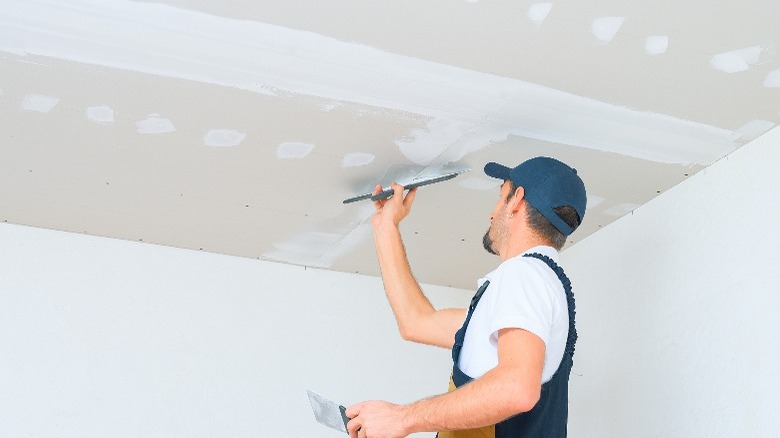A Handy Way To Cover Unsightly Popcorn Ceilings Without Scraping
We may receive a commission on purchases made from links.
Popcorn ceilings had their heyday, but in the modern home, these antiquated features do little more than drag down the design. If you want a completed look for your house's updated interior, you have no choice but to do something about them. Scraping the popcorn ceiling is an obvious approach for those with the endurance for it. But when you aren't careful, you could unwittingly run into issues by going this route. Painted popcorn and dangerous substances like asbestos are just some of the many problems with popcorn ceilings that may force you to find alternative solutions like covering them up. While it may not be as cheap as smoothing the existing surface, adding an overlay is a safer and cleaner way to improve the aesthetic.
The great thing about putting a cover over your popcorn ceiling is that there is no shortage of options. One of the easiest is gluing up textured or patterned ceiling panels. YouTube channel Decorative Ceiling Tiles, Inc. outlines the process of measuring your ceiling, applying adhesive, and setting your tiles in place. They're simple to put up, and you can easily cut around any fixtures with a utility knife. While you may not want to put these up throughout the whole home, they're a perfect way to liven up a dining or living room. Shiplap is another popular choice bringing rustic or coastal vibes into the room. For a more traditional flat surface, though, you'll want to opt for good old drywall.
Cover your outdated popcorn ceilings with drywall
Laying drywall over your popcorn ceiling gives you an easily paintable surface and enough versatility to style the ceiling any way you see fit. If you feel more comfortable doing so, you can also get the same smoothness by skim-coating your ceiling. Still, using drywall will be faster, cleaner, and possibly easier. Plus, the extra gypsum board can add sound-proofing, insulation, and fire resistance, depending on its design. But when you're laying new drywall to cover a popcorn ceiling, an easy-to-install solution like USG Sheetrock's UltraLight Drywall is often the best option.
Drywall goes over the popcorn ceiling and attaches to the wood ceiling joists in a brick-like pattern. Find and mark the ceiling joists with a stud finder so you know your attachment points. Lay the panels one at a time, using coarse-thread drywall screws and a countersink bit to drill them into the joists. With the panels placed, you can tape and apply joint compound to the drywall, covering the seams, screw holes, and corners. Sand the compound to make it smooth and level with the drywall. Once complete, you can apply a coat of primer and your favorite choice of paint. The completed installation will make your popcorn ceiling a thing of the past, leaving a clean and clear flat surface that can work with almost any style and remain flexible as your tastes change.

